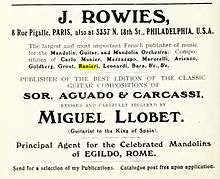Edgar Bara
Edgar Bara (1876–1962)[1] was a mandolinist, author and composer. He wrote the method book Méthode de Mandoline et Banjoline, published 1903 in the United States, one of the few from that era which is still in print today, in France. He was also a conductor of a mandolin orchestra in Paris, the Cercle Mandoliniste in 1907.[2][3]

Advertisement for music publisher J. Rowies (Philadelphia, Pennsylvania) for mandolin sheet music. Included mention of Bara, alongside Salvador Leonardi, Eduardo Mezzacapo, Enrico Marucelli, Silvio Ranieri and Carlo Munier. Taken from the book The guitar and mandolin, Biographies of celebrated players and composers for these instruments by Philip J. Bone, published by Schott and Company, London, 1914.
Works
- Lucia di Lammermoor
- Une Nuit à Bone Sérénade algérienne (pour violon et piano) Op. 103
- Une Fête à Séville, boléro
- Les Hallebardiers passent! Retraite pour piano et mandoline Op. 48
- La Veuve joyeuse, célèbre valse de Franz Lehar. Arrangée pour violon (ou mandoline) ou piano
- La Traviata, opéra de Verdi. Fantaisie
- La Norma, opéra de V. Bellini. Fantaisie pour mandoline et piano Op. 52
- La Esméralda, piano
- Indiscrétion, piano
gollark: It says "unlocked", not "open".
gollark: Don't be kelp, LyricLy.
gollark: (<@332271551481118732> did it, I shoved it into potatOS)
gollark: (kind of hackily, so it's opt in, but it works)
gollark: PotatOS now supports algebraic data types.
See also
References
- Manfred Kelkel (1994). Musique et esthétique. J. Vrin. p. 79. ISBN 978-2-7116-4279-3. Retrieved 18 July 2013.
- Paul Sparks, The Classical Mandolin, Oxford University Press, pages 104, 108, 215
- Mando Island, Edgar Bara (1876 - 1962) - Methode de Mandoline et Banjoline
This article is issued from Wikipedia. The text is licensed under Creative Commons - Attribution - Sharealike. Additional terms may apply for the media files.